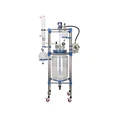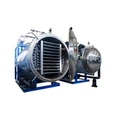
If temperature control alone is insufficient to drive your synthesis or degradation, light is required. A photochemical reactor / photochemical reactor combines UV/VIS/LED sources with the reactor to synthesize new molecules or decompose organics that reactors using heating alone cannot handle. This guide outlines applications, model families, and a practical seven-step method for selection using TOPTION's current portfolio as a reference.
Key Takeaways
- Select by phase state first: liquid → TOPT-II / TOPT-V; solid → TOPT-7S; gas →TOPT-9G; pressure or special alloys → TPR-S/HP.
- Light sources to choose from: UV (mercury), xenon (long/short arc; UV-enhanced), and custom LED; for specific wavelengths, utilize filters or LEDs.
- For parallel liquid screens, utilize TOPT-V (8 vials, 10/30/50/100 mL). For single-sample liquids, select TOPT-II (250/500/1000 mL; side ports for gas/temperature/sampling).
- Over 30 minutes of irradiation requires a chiller matched to the lamp wattage; for constant temperature, the temperature control should match with double-jacket reactors.
- Materials & pressure: no-pressure → quartz/glass; with pressure → stainless, titanium, Hastelloy, typically ≤7 bar.
Description
When do you need a photochemical reactor?
When a standard reactor cannot reach the desired transformation with temperature control, and the route requires UV/VIS light to either synthesize new molecules or to degrade organics.

Light Sources Overview
- UV (mercury lamp)
- Xenon: Available in long-arc or short-arc configurations and has optional UV-enhanced models. TOP-X300 xenon pairs with filter sets (point source, ~50 mm spot).
- LED: custom single wavelength light modules (ex., 254 nm, 420 nm)


photochemical reactor series divided by phase state and operating conditions
Liquid Phase / Liquid-rich Mixtures
- TOPT-II – single sample, 250/500/1000 mL with three side ports (gas in, temp probe, sampling). Custom larger volumes available.
- TOPT-V – 8-position parallel reactor for 10/30/50/100 mL vials, with standard silicone stoppers. When you need custom quartz vials with ports for thermometry, gas in/out, sampling, or constant temperature, ideal for university research and corporate laboratory development.

Solid Phase
TOPT-7S – designed for solid-phase photochemistry.


Gas Phase / Gas-rich Mixtures
TOPT-9G – designed for pure gas reactions. If pressure or special materials are involved, consider TPR-HP/TPR-S with TOP-X short-arc/spherical xenon.



Extreme Temperature & Scale-up
- TPRC – standard −20 °C for low-temperature photochemistry; is capable of going to lower points as custom requests.
- TPR-M – pilot/production series: 5/10/20/30/50/100 L (and beyond).
Eight-Step Selection
-
UV Light (Mercury Lamp)
-
Visible Light (Long-Arc and Short-Arc Xenon Lamps)
-
Custom Light Sources (UV-enhanced Xenon Lamps, LED Light Sources)
- Pure Liquid Phase
- Pure Solid Phase
- Pure Gas Phase
- Mixed State (If mixed, confirm the proportion of the primary phase)
Optics & Safety
- Filters: Supported on TOPT-V and TOP-X xenon; other models do not support filters. For single wavelength, use TOP-X LED (e.g., 254 nm, 420 nm).
- Dark box: Long, intense exposure harms skin and eyes; add a light-shielding enclosure.
- Chiller sizing: base it on lamp wattage and target temperature; long runs need low-temperature chillers.
Technical Deep Dive
TOPT-II (liquid)
250/500/1000 mL, each single sample; three side ports for gas in, thermometry, sampling; larger volumes can be custom-made. Select a double-jacket for constant temperature and/or flow gas management.
TOPT-V (parallel liquid)
Holds 8 samples in 10/30/50/100 mL vials; includes regular silicone stoppers; can be custom-made with quartz vials that have temperature/gas/sampling features.
TOPT-7S (solid)
Designed for solid-phase photochemistry.
TOPT-9G (gas)
Aimed at pure gas reactions; if pressure or exotic materials are your focus, use TPR-S/HP with appropriate xenon optics.
TPRC (low temperature)
Standard at −20 °C. Lower set points are custom.
TPR-M (scale-up)
Standard 5–100 L, larger customization available.
TPR-S
This model belongs to the high-pressure reactor series and is typically paired with TOP-X series short-arc light sources or spherical lamp light sources.
The TOPTION Photochemical reactorsAdvantage

🔦 Material: High borosilicate glass – resistant to strong acid & alkali, high temperature.
🔦 All quartz cold trap with light source protection--connect to a low temperature refrigerating machine, effectively protects the light source, longer life for the light source.
🔦 Safety glass – A specially designed glass to protect the operator's safety and health.
🔦 For different light sources -when using mercury lamp (100W-1000W), xenon lamp, metal halide lamp (100W-4500W), etc.
🔦 Non-standard glass reactor size can be customized – from 100ml, 200L, 3000ml, or 5L.
🔦 Refrigerated chiller – for accurate temp. control of -20 °C~100 °C.
Quick-Match Scenarios
1. Academic liquid screening
TOPT-V + xenon + filter set + (as needed) double-jacket + chiller. Default pick for multi-condition catalyst work.
2. Routine enterprise lab (single flask)
TOPT-II at 250–1000 mL, customize side ports and jackets as required.
3. Gas-phase or pressured workflows
TOPT-9G, or move to TPR-S/HP with TOP-X xenon when pressure/materials dictate.
FAQ
Q1. When do I need a chiller?
If irradiation exceeds 30 minutes, please determine a low-temperature chiller sized to lamp wattage (300/500/1000 W references available).
Q2. Which models support optical filters or single wavelengths?
Filters: TOPT-V and TOP-X xenon. For single wavelength, use TOP-X LED (e.g., 254 nm, 420 nm).
Q3. How do I choose reactor materials under pressure?
No pressure → quartz/glass. With pressure → stainless, titanium, Hastelloy; typical max ≈7 bar depending on design.
About Us





Watch more!




